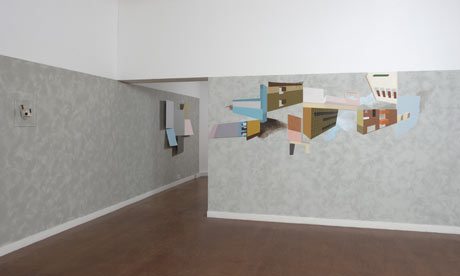Just got back from the artist's talk at The Fruitmarket, with Toby Paterson in conversation with Fiona Bradley (Director of The Fruitmarket). I don't go to as many artist's talks as I should do, mainly because they use too many big words and I lose interest within the first 15 minutes. However, I found this talk really engaging. Paterson was able to explain his intentions around his work, how his work has progressed and why he'd set up the exhibition as he did. I took a few notes and this is what I got out of the scribbles:
- On 'Utopian Architecture': "In a way I wished they had worked, but I'm kind of glad they haven't. Thankfully they're still here". He called the idea of Utopia fascinating and horrifying and explained that his work isn't a homage but "comfortably looking back in hindsight". When talking about architecture in general and how it influence his work, he described it as a "Repository of subject matter" in terms of colour, texture and form.
- On his collages: "It was a way of using lots of source material as a step on the way to something else."
- On the gallery space: He said that he wanted the viewer to move around the lower gallery as they would through a promenade in a city. The density of work was self-sabotaging and the viewer may miss things, as they would in an urban environment. The upper gallery was blocked off on the left side of the stairs and Fiona Bradley stated that that was the natural direction that people would walk. Paterson created a sort of spiral to walk around. Bradley also mentioned that the spaces that the work were hung in would normally be 'dead spaces' within the usual layout of the gallery.
Paterson talked a lot about Glasgow as a reference point for his work. They discussed the evolution of cities and how buildings that had always been there as long as you could remember had been demolished to be replaced by buildings that were going to be in essence the same. But due to the current economic situation, these sites are still empty. Paterson described these spaces as 'contemporary bombsites', which was a wonderful way to contextualise it. It also refers to his work about regenerated war damaged cities.
The best way I can summarise the talk is by again quoting Paterson. Referring to the use of Modernist and New Brutalist architecture in his work, he said "It's not about changing how people look at it, I changed how I looked at it".
Wednesday, 24 February 2010
Monday, 1 February 2010
Toby Paterson


"From the overlapping cement blocks of a Le Corbusier high-rise to the angular dimensions of a 1960s depot, Paterson reveals the intrinsic failure of modernism: that only when isolated can its products' true beauty be experienced. The result also reminds us of the social beliefs that originally underpinned all those Brutalist housing estates, cement pavilions and dingy underpasses, ideals that had been lost amid a bitter aesthetic controversy." - Jessica Lack, The Guardian, March 2009
Well I could have told you that...
Went to see the Toby Paterson exhibition at the Fruitmarket Gallery today and my first thought was that I might as well chop my hands off and never make anything ever again. I felt as if I was looking at all my ideas executed in a way that is better than I could ever do and I was so incredibly frustrated that as I walked around the space I couldn't help swearing under my breath. However, as I've started to read up about his work, it's becoming less frustrating and more inspiring. Paterson's work is a celebration of the form and line within post-war architecture. He transforms imposing concrete blocks into the weightless utopias they were intended to be, which is such a positive thing for me to see because that's what I've been trying to do with my work. The colours, the layout and the materials Paterson uses work perfectly together to 'resemble walking through a city, with images coming unexpectedly into view'. The books on display and the talks coming up at the gallery will be so useful for the research part of my practice. To sum up, I love this show. I'm going back tomorrow. And i'm buying the exhibition catalogue. But I'm still ridiculously jealous.
Subscribe to:
Posts (Atom)
